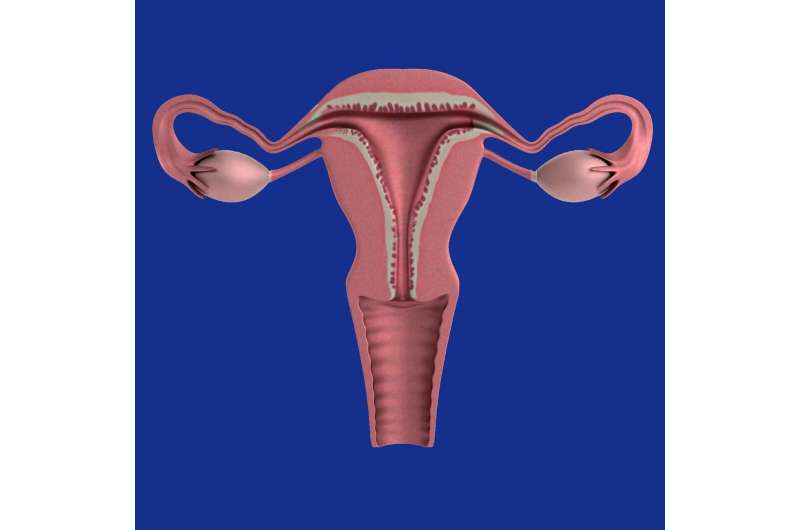This article has been reviewed according to Science X's editorial process and policies. Editors have highlighted the following attributes while ensuring the content's credibility:
fact-checked
peer-reviewed publication
trusted source
proofread
Risk-stratification algorithm significantly reduces unnecessary ovary removal in girls, study shows

Many children and adolescent girls diagnosed with an ovarian mass may be able to avoid ovary removal and its lifelong consequences with the use of a consensus-based risk stratification algorithm. Algorithm use helps doctors gauge the patient's risk of a malignancy and guides preoperative decision making, according to a new multi-institutional study published in the Journal of the American Medical Association (JAMA).
Researchers at 11 U.S. children's hospitals found that preoperative use of the algorithm reduced unnecessary ovary removals or oophorectomies from 16.1% of cases before the algorithm was used to 8.4% when it was integrated into practice.
The tool—designed by a multidisciplinary team of pediatric surgeons, pediatric and adolescent gynecologists, radiologists, and medical oncologists—very accurately steered low-risk patients to ovary-sparing surgery, misclassifying only 0.7% of those with a malignancy.
"We were very pleased to find that our algorithm significantly reduced unnecessary ovary removal in cases of benign masses and accurately directed these patients to ovary-sparing surgery," said lead author Peter C. Minneci, MD, MHSc, Chair of the Department of Surgery at Nemours Children's Health, Delaware Valley.
"Oophorectomies can have a number of negative effects on young patients' health, and this evidence-based tool for preoperative risk stratification and decision-making helps minimize the number oophorectomies performed in the setting of benign masses."
Oophorectomy can lead to premature ovarian failure, early menopause and increased risks of cognitive impairment, osteopenia, impaired sexual health, and cardiovascular disease. Yet the rates of using ovary-sparing surgery in children whose masses turned out to be benign can range from only 18% up to 77%, depending on the institution and the type of specialist treating a patient—a pediatric surgeon or a pediatric and adolescent gynecologist.
"Adoption of this algorithm could prevent significant lifelong harm caused by unnecessary oophorectomy during adolescence," the authors concluded.
This study assessed the algorithm's ability to accurately distinguish between benign and malignant ovarian masses, in hopes of decreasing the number of oophorectomies for benign masses. It included 519 patients aged 6 to 21 undergoing inpatient surgery for an ovarian mass: 96 patients were in a preintervention phase where the algorithm was not used; 105, in an algorithm adoption phase (not included in statistical comparisons); and 318, in the implementation phase using the algorithm.
Researchers in the study—whose institutions are members of the Midwest Pediatric Surgery Consortium—developed the algorithm, which resembles a decision tree. The impetus for this research came from a case of pediatric surgeon Katherine J. Deans, MD, MHSc, the study's senior author, now Surgeon-in-Chief at Nemours Children's Health, Delaware Valley.
In discussing the patient's case with a colleague in pediatric and adolescent gynecology, Deans recognized that the specialists were approaching the decision from very different perspectives—prioritizing removal of a potentially malignant mass vs. prioritizing preservation of the patient's reproductive and long-term health.
"I realized that this important surgical decision depended very much on the perspective of the specialist who saw the patient. What we really needed is reliable evidence-based pre-operative risk stratification to help guide the decision," said Deans. "This understanding has sparked earlier studies by Consortium members and ultimately the development and implementation of this algorithm, which our study shows removes the variability of care."
The full algorithm is included in the publication in JAMA with additional information in the accompanying supplement.
The authors plan future studies to build on these findings by further analyzing the data to refine the algorithm. They also plan to study ways to improve fidelity in using it and to conduct implementation studies with additional institutions.
More information: Katherine J. Deans et al, Reducing Unnecessary Oophorectomies for Benign Ovarian Neoplasms in Pediatric Patients, Journal of the American Medical Association (2023). DOI: 10.1001/jama.2023.17183




















